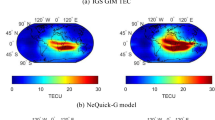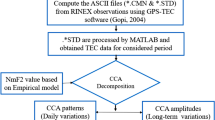Abstract
We studied variation characteristics of ionospheric total electron contents (TEC) and performance of the International Reference Ionosphere (IRI)-2012 model in predicting TEC at the BJFS (Beijing Fangshan station), China. Diurnal and seasonal variations were analyzed with TEC data derived from dual-frequency global positioning system (GPS) observations along with the solar activity dependence of TEC at the BJFS station. Data interpolated with information from IGS Global Ionosphere Maps (GIMs) were also used in the analysis. Results showed that the IRI-2012 model can reflect the climatic characteristics and solar activity dependence of ionospheric TEC. By using time series decomposition method, ionospheric daily averaged TEC values were divided into the periodic components, geomagnetic activity component, solar activity component and secular trend. Solar activity component and periodic components are supposed to be the main reasons which account for the difference between the GIMs TEC and the TEC from the IRI-2012 model.
Article PDF
Similar content being viewed by others
Avoid common mistakes on your manuscript.
References
Abdu, M.A., I.S. Batista, and J.R. de Souza (1996), An over view of IRIobservational data comparison in American (Brazilian) sector low latitude ionosphere, Adv. Space Res. 18, 6, 13–22, DOI: 10.1016/0273-1177(95)00893-4.
Adebiyi, S.J., O.O. Odeyemi, I.A. Adimula, O.A. Oladipo, S.O. Ikubanni, B.O. Adebesin, and B.W. Joshua (2014), GPS derived TEC and foF2 variability at an equatorial station and the performance of IRI-model, J. Adv. Space Res. 54, 4, 565–575, DOI: 10.1016/j.asr.2014.03.026.
Aggarwal, M. (2011), TEC variability near northern EIA crest and comparison with IRI model, Adv. Space Res. 48, 7, 1221–1231, DOI: 10.1016/j.asr.2011.05.037.
Arikan, F., O. Arikan, and C.B. Erol (2007), Regularized estimation of TEC from GPS data for certain mid latitude stations and comparison with the IRI model, Adv. Space Res. 39, 5, 867–874, DOI: 10.1016/j.asr.2007.01.082.
Arunpold, S., N. Tripathi, R. Chowdhary, V.R. Chowdhary, and D.K. Raju (2014), Comparison of GPS-TEC measurements with IRI-2007 and IRI-2012 modeled TEC at an equatorial latitude station, Bangkok, Thailand, J. Atmos. Sol. Terr. Phys. 117, 88–94, DOI: 10.1016/j.jastp.2014.06.001.
Asmare, Y., T. Kassa, and M. Nigussie (2014), Validation of IRI-2012 TEC model over Ethiopia during solar minimum (2009) and solar maximum (2013) phases, Adv. Space Res. 53, 11, 1582–1594, DOI: 10.1016/j.asr.2014.02.017.
Bhuyan, P.K., and R. Hazarika (2013), GPS TEC near the crest of the EIA at 95E during the ascending half of solar cycle 24 and comparison with IRI simulations, Adv. Space Res. 52, 7, 1247–1260, DOI: 10.1016/j.asr.2013.06.029.
Bilitza, D., M. Hernandez-Pajares, J.M. Juan, and J. Sanz (1999), Comparision between IRI and GPS-IGS derived electron content during 1991–97, Phys. Chem. Earth 24, 4, 311–319, DOI: 10.1016/S1464-1917(99)00004-5.
Bilitza, D. (2001), International Reference Ionosphere 2000, Radio Sci. 36, 2, 261–275, DOI: 10.1029/2000RS002432.
Bilitza, D., and B.W. Reinisch (2008), International Reference Ionosphere2007: Improvements and new parameters, Adv. Space Res. 42, 4, 599–609, DOI: 10.1016/j.asr.2007.07.048.
Bilitza, D., L.A. McKinnell, B. Reinisch, and T. Fuller-Rowell (2011), The international reference ionosphere today and in the future, J. Geodesy 85, 12, 909–920, DOI: 10.1007/s00190-010-0427-x.
Bilitza, D., D. Altadill, Y. Zhang, C. Mertens, V. Truhlik, P. Richards, L.A. McKinnell, and B. Reinisch (2014), The International Reference Ionosphere 2012–a model of international collaboration, J. Space Weather Space Clim. 4, A07, 1–12, DOI: 10.1051/swsc/2014004.
Bilitza, D. (2015), The International Reference Ionosphere — Status 2013, Adv. Space Res. 55, 8, 1914–1927, DOI: 10.1016/j.asr.2014.07.032.
Dai, K., and J. Ma (1994), Comparison of total electron content calculated using the IRI with observations in China, J. Atmos. Sol. Terr. Phys. 56, 3, 417–422, DOI: 10.1016/0021-9169(94)90222-4.
Ephishov, I.I., L.W. Baran, I.I. Shagimuratov, and G.A. Yakimova (2000), Comparison of total electron content obtained from GPS with IRI, Phys. Chem. Earth 25, 4, 339–342, DOI: 10.1016/S1464-1917(00)00028-3.
Ezquer, R., C. Brunini, M. Mosert, A. Meza, R. del V. Oviedo, E. Kiorcheff, and S.M. Radicella (2004), GPS-VTEC measurements and IRI predictions in the South American sector, Adv. Space Res. 34, 9, 2035–2043, DOI: 10.1016/j.asr.2004.03.015.
Feltens, J., M. Angling, N. Jackson-Booth, N. Jakowski, M. Hoque, M. Hernández-Pajares, Á. Aragón, Á. María, and R. Orús-Pérez (2011), Comparative testing of four ionospheric models driven with GPS measurements, Radio Sci. 46, 6, RS0D12, DOI: 10.1029/2010RS004584.
Gulyaeva, T.L., and D.L. Gallagher (2007), Comparison of two IRI electron-density plasmasphere extensions with GPS-TEC observations, Adv. Space Res. 39, 5, 744–749, DOI: 10.1016/j.asr.2007.01.064.
Gulyaeva, T.L., and D. Bilitza (2012), Towards ISO standard Earth ionosphere and plasmasphere model. In: New Developments in the Standard Model, NOVA Publishers, https://www.novapublishers.com/catalog/product_info.php?products_id=35812.
Hochegger, G., B. Nava, S.M. Radicella, and R. Leitinger (2000), A family of ionospheric models for different uses, Phys. Chem. Earth 25, 4, 307–310, DOI: 10.1016/S1464-1917(00)00022-2.
Jee, G., R.W. Schunk, and L. Scherliess (2005), Comparison of IRI-2001 with TOPEX TEC measurements, J. Atmos. Sol. Terr. Phys. 67, 4, 365–380, DOI: 10.1016/j.jastp.2004.08.005.
Jin, R., S. Jin, and G. Feng (2012), M_DCB: Matlab code for estimating GNSS satellite and receiver differential code biases, GPS Solut. 16, 4, 541–548, DOI: 10.1007/s10291-012-0279-3.
Karia, S.P., N.C. Patel, and K.N. Pathak (2015), Comparison of GPS based TEC measurements with the IRI-2012 Model for the period of low to moderate solar activity (2009–2012) at the crest of equatorial anomaly in Indian region, Adv. Space Res.55, 8, 1965–1975, DOI: 10.1016/j.asr.2014.10.026.
Kenpankho, P., P. Supnithi, and Nagatsuma (2013), Comparison of observed TEC values with IRI-2007 TEC and IRI-2007TEC with optional foF2 measurements predictions at an equatorial region, Chumphon, Thailand, Adv. Space Res. 52, 10, 1820–1826, DOI: 10.1016/j.asr.2013.08.012.
Klobuchar, J.A. (1987), Ionospheric Time-Delay Algorithm for Single-Frequency GPS users, IEEE Trans. Aerosp. Electron. Syst. 23, 3, 324–331, DOI: 10.1109/TAES.1987.310829.
Lee, H.B., G. Jee, Y.H. Kim, and J.S. Shim (2013), Characteristics of global plasmaspheric TEC in comparison with the ionosphere simultaneously observed by Jason-1 satellite, J. Geophys. Res. 118, 2, 935–946, DOI: 10.1002/jgra.50130.
Leong, S.K., T.A. Musa, K. Omar, M.D. Subari, N.B. Pathy, and M.F. Asilam (2015), Assessment of ionosphere models at Banting: Performance of IRI- 2007, IRI-2012 and Ne-Quick 2 models during the ascending phase of Solar Cycle 24, J. Adv. Space Res. 55, 8, 1928–1940, DOI: 10.1016/j.asr.2014.01.026.
Li, H., Y. Yuan, Z. Li, X. Huo, and W. Yan (2012), Ionospheric electron concentration imaging using combination of LEO satellite data with ground-based GPS observations over China, IEEE Trans. Geosci. Remote Sens. 50, 5, 1728–1735, DOI: 10.1109/TGRS.2011.2168964.
Li, S., J. Peng, W. Xu, and K. Qin (2013), Time series modeling and analysis of trends of daily averaged ionospheric total electron content, Adv. Space Res. 52, 5, 801–809, DOI: 10.1016/j.asr.2013.05.032.
Li, Z., Y. Yuan, N. Wang, M. Hernandez-Pajares, and X. Huo (2015), SHPTS: towards a new method for generating precise global ionospheric TEC map based on spherical harmonic and generalized trigonometric series functions, J. Geodesy 89, 4, 331–345, DOI: 10.1007/s00190-014-0778-9.
Luo, W., Z. Liu, and M. Li (2014), A preliminary evaluation of the performance of multiple ionospheric models in low- and mid-latitude regions of China in 2010–2011, GPS Solut. 18, 2, 297–308, DOI: 10.1007/s10291-013-0330-z.
Maltseva, O.A., N.S. Mozhaeva, O.S. Poltavsky, and G.A. Zhbankov (2012), Use of TEC global maps and the IRI model to study ionospheric response to geomagnetic disturbances, Adv. Space Res. 49, 6, 1076–1087, DOI: 10.1016/j.asr.2012.01.005.
Migoya Orué, Y.O., S.M. Radicella, P. Coïsson, R.G. Ezquer, and B. Nava (2008), Comparing TOPEX TEC measurements with IRI predictions, Adv. Space Res. 42, 4, 757–762, DOI: 10.1016/j.asr.2007.09.041.
Mosert, M., M. Gende, C. Brunini, R. Ezquer, and D. Altadill (2007), Comparisons of IRI TEC predictions with GPS and digisonde measurements at Ebro, Adv. Space Res.39, 5, 841–847, DOI: 10.1016/j.asr.2006.10.020.
Nava, B., P. Coïsson, and S.M. Radicella (2008), A new version of the NeQuick ionosphere electron density model, J. Atmos. Sol. Terr. Phys. 70, 15, 1856–1862, DOI: 10.1016/j.jastp.2008.01.015.
Nogueira, P.A.B., M.A. Abdu, J.R. Souza, I.S. Batista, and G.J. Bailey (2013), Equatorial ionization anomaly development as studied by GPS TEC and foF2 over Brazil: A comparison of observations with model results from SUPIM and IRI-2012, J. Atmos. Sol. Terr. Phys. 104, 45–54, DOI: 10.1016/j.jastp.2013.08.013.
Okoh, D., L. McKinnell, P. Cilliers, and P. Okeke (2013), Using GPS-TEC data to calibrate VTEC computed with the IRI model over Nigeria, Adv. Space Res. 52, 10, 1791–1797, DOI: 10.1016/j.asr.2012.11.013.
Panda, S.K., S.S. Gedam, and G. Rajaram (2015), Study of Ionospheric TEC from GPS observations and comparisons with IRI and SPIM model predictions in the low latitude anomaly Indian sub continental region, J. Adv. Space Res. 55, 8, 1948–1964, DOI: 10.1016/j.asr.2014.09.004.
Rabiu, A.B., A.O. Adewale, R.B. Abdulrahim, and E.O. Oyeyemi (2014), TEC derived from some GPS stations in Nigeria and comparison with the IRI and NeQuick models, J. Adv. Space Res. 53, 9, 1290–1303, DOI: 10.1016/j.asr.2014.02.009.
Rawer, K., D. Bilitza, and S. Ramakrishnan (1978), International Reference Ionosphere 1978, International Union of Radio Science (URSI), Brussels, Belgium.
Scidá, L.A., R.G. Ezquer, M.A. Cabrera, M. Mosert, C. Brunini, and D. Buresova (2012), On the IRI 2007 performance as a TEC predictor for the South American sector, J. Atmos. Sol. Terr. Phys. 81–82, 50–58, DOI: 10.1016/j.jastp.2012.04.001.
Wen, D., Y. Yuan, J. Ou, K. Zhang, and K. Liu (2008), A hybrid reconstruction algorithm for 3-d ionospheric tomography, IEEE Trans. Geosci. Remote Sens. 46, 6, 1733–1739, DOI: 10.1109/TGRS.2008.916466.
Xiang, Y., Y. Yuan, Z. Li, and N. Wang (2015), Analysis and validation of different global ionospheric maps (GIMs) over China, J. Adv. Space Res. 55, 1, 199–210, DOI: 10.1016/j.asr.2014.09.008.
Yuan, Y., and J. Ou (2001), Auto-covariance estimation of variable samples (ACEVS) and its application for monitoring random ionospheric disturbances using GPS, J. Geodesy 75, 7–8, 438–447, DOI: 10.1007/s001900100197.
Yuan, Y., and J. Ou (2002), Differential areas for differential stations (DADS): a new method of establishing grid ionospheric model, Chin. Sci. Bull. 47, 12, 1033–1036, DOI: 10.1360/02tb9232.
Yuan, Y., X. Huo, J. Ou, K. Zhang, Y. Chai, D. Wen, and R. Grenfell (2008a), Refining the Klobuchar ionospheric coefficients based on GPS observations, IEEE Trans. Aerosp. Electron. Syst. 44, 4, 1498–1510.
Yuan, Y., C.C. Tscherning, P. Knudsen, G. Xu, and J. Ou (2008b), The ionospheric eclipse factor method (IEFM) and its application to determining the ionospheric delay for GPS, J. Geodesy 82, 1, 1–8, DOI: 10.1007/s00190-007-0152-2.
Zakharenkova, I.E., Iu.V. Cherniak, A. Krankowski, and I.I. Shagimuratov (2015), Vertical TEC representation by IRI 2012 and IRI Plas models for European mid latitudes, J. Adv. Space Res. 55, 8, 2070–2076, DOI: 10.1016/j.asr.2014.07.027.
Author information
Authors and Affiliations
Corresponding author
Rights and permissions
Open Access This article is distributed under the terms of the Creative Commons Attribution 4.0 International License (https://creativecommons.org/licenses/by/4.0), which permits use, duplication, adaptation, distribution, and reproduction in any medium or format, as long as you give appropriate credit to the original author(s) and the source, provide a link to the Creative Commons license, and indicate if changes were made.
About this article
Cite this article
Li, S., Li, L. & Peng, J. Variability of Ionospheric TEC and the Performance of the IRI-2012 Model at the BJFS Station, China. Acta Geophys. 64, 1970–1987 (2016). https://doi.org/10.1515/acgeo-2016-0075
Received:
Revised:
Accepted:
Published:
Issue Date:
DOI: https://doi.org/10.1515/acgeo-2016-0075




